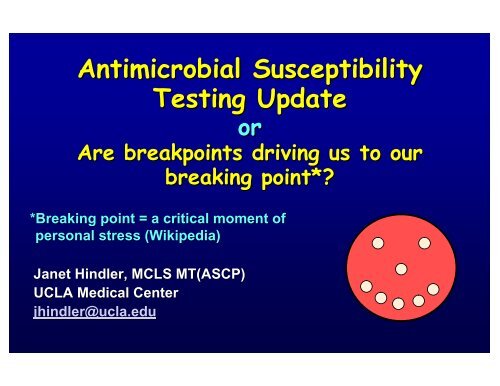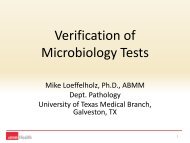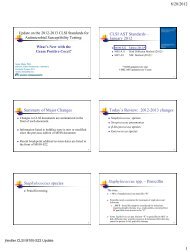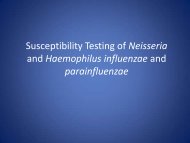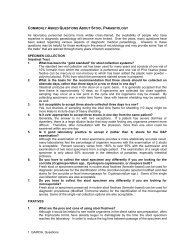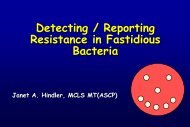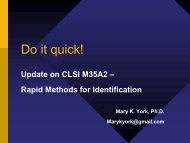Antimicrobial Susceptibility Testing Update - SWACM
Antimicrobial Susceptibility Testing Update - SWACM
Antimicrobial Susceptibility Testing Update - SWACM
- No tags were found...
You also want an ePaper? Increase the reach of your titles
YUMPU automatically turns print PDFs into web optimized ePapers that Google loves.
<strong>Antimicrobial</strong> <strong>Susceptibility</strong><strong>Testing</strong> <strong>Update</strong>orAre breakpoints driving us to ourbreaking point*?*Breaking point = a critical moment ofpersonal stress (Wikipedia(Wikipedia)Janet Hindler, MCLS MT(ASCP)UCLA Medical Centerjhindler@ucla.edu
At the conclusion of this talk,you will be able to…… List some of the new recommendations forantimicrobial susceptibility testing andreporting as published in CLSI M100-S20andCLSI M100-S20S20-U (June 2010 <strong>Update</strong>). Discuss reporting results from testingcephalosporins and carbapenems againstEnterobacteriaceae. Describe strategies for implementation ofrevised breakpoints into clinical laboratorytesting protocols.
CLSI AST StandardsAugust 2010M100-S20Tables (January 2010)*– Revised cephalosporin & aztreonam breakpoints(Enterobacteriaceae)M100-S20-U (June 2010)– Revised carbapenem breakpoints (Enterobacteriaceae)M02-A10M07-A8Disk Diffusion Method (2009)**MIC Method (2009)**
StandardsSettingRegulatoryStandardsSettingRegulatoryCLSIFDAEUCASTEMEASets breakpointsReassessesbreakpointsSets breakpoints2010 - developingmechanism to reassessbreakpointsSets breakpointsEMEA sets breakpointsthrough EUCASTManufacturers of AST systems must use FDA breakpoints• CLSI = Clinical and Laboratory Standards Institute (formerly NCCLS)• EUCAST = European Committee on <strong>Antimicrobial</strong> <strong>Susceptibility</strong> <strong>Testing</strong>• EMEA = European Medicines Agency
Ceftriaxone Prescribing Information - FDA Breakpointshttp://media.pfizer.com/files/products/uspi_ceftriaxone.pdf
Status of FDA Breakpoint RevisionsFDA Amendments Act (FDAAA) of 2007contains 200 provisions re: drugmarketing/labeling– requires FDA to update drug labelsFDA Guidance Documents (2009)– Will consider breakpoints of national or internationalstandards organizations– Describes approach for pharmaceutical companies toupdate breakpoints in prescribing informationCLSI leadership maintaining close watch
Enterobacteriaceae - CephalosporinsRevised… Breakpoints (MIC µg/ml)*AgentCefepime**CLSI 2009 (Old)Susc≤8Int16Res≥32CLSI 2010 (New)SuscIntNo changeResCefazolin ≤8 16 ≥32≤1 2 ≥4Cefotaxime ≤8 16-32≥64≤1 2 ≥4Ceftriaxone ≤8 16-32≥64≤1 2 ≥4Ceftazidime ≤8 16 ≥32≤4 8 ≥16Aztreonam ≤8 16 ≥32≤4 8 ≥16* January 2010** No change; also reevaluated and no change for cefuroxime, cefoxitin,cefotetan, cefmetazoleCorresponding disk diffusion breakpoints also revised
Enterobacteriaceae - CarbapenemsRevised… Breakpoints (MIC µg/ml)*AgentCLSI 2010 (Old)SuscIntResCLSI June 2010 (New)SuscIntResDoripenem - - - ≤1 2 ≥4Ertapenem ≤2 4 ≥8 ≤0.250.5 ≥1Imipenem ≤4 8 ≥16≤1 2 ≥4Meropenem ≤4 8 ≥16≤1 2 ≥4*June 2010Corresponding disk diffusion breakpoints also revised
Table 2A Enterobacteriaceae♦ Dosing information reflects FDA-approved standard adult dosinglisted in Prescribing Information (Drug Label)♦ When implementing revised breakpoints, laboratories MUST inform IDand Pharmacy that these were the dosing regimens on which thebreakpoints were based♦ NOT intended for labs to list this on patient report
Why did CLSI lower cephalosporin,aztreonam, and carbapenem breakpointsfor Enterobacteriaceae? (1) Most of these breakpoints were established over20 years ago (before ESBLs and when virtually allEnterobacteriaceae were “S” to carbapenems) Newer tools / data to establish breakpoints (e.g.,PK/PD with Monte Carlo simulations) Lowering breakpoints would have minimal impacton % “S” for most 3rd generation cephalosporins,aztreonam. and carbapenems Increased knowledge of old and newer β-lactamresistance mechanisms
Why did CLSI lower cephalosporin,aztreonam, and carbapenem breakpointsfor Enterobacteriaceae? (2) Re: cephalosporin and aztreonam breakpoints– CLSI ESBL test only standardized for E. coli, Klebsiellaspp. and Proteus mirabilis (mid 1990s)• ESBLs occur in other species• ESBLs not always detected if multiple R mechanisms present For ESBL positive isolates:– Low MICs to selected cephalosporins associated withbeing poor substrates for specific ESBL– Animal studies indicated % T > MIC did not differ forESBL positive vs. ESBL negative Enterobacteriaceae– Animal studies showed no inoculum effect w/ ESBLproducers
Why did CLSI lower cephalosporin,aztreonam, and carbapenem breakpointsfor Enterobacteriaceae? (3)Re: Carbapenem breakpoints– Modified Hodge test• Subjective interpretation• Does not detect all carbapenem “R”mechanisms
Old ParadigmEmergence of a new β-lactamase(e.g., ESBL or carbapenemase)Perform screen test for resistance mechanism(elevated MICs near “S” breakpoint are “suspicious”)ESBLPerform special confirmatory testfor resistance mechanismChange the susceptibility report if resistancemechanism is detectedMHT
New ParadigmIsolation of EnterobacteriaceaePerform tests for susceptibility andapply the new “lower” breakpointsReport the susceptibility results for treatmentpurposes - no editing of “S” resultsPerform special tests for resistancemechanisms only for infection control andepidemiological purposes
www.eucast.org
Setting / Revising BreakpointsData Used by CLSIMIC distributions of “wild type” ornormal populations of bacteria– Wild type = no acquired “R” mechanismsMICs associated with clinical outcome– Very limited “new” data for older drugsPharmacokinetic-pharmacodynamic(PK-PD) PD) analysis
MEROPENEM MIC distribution exampleBlue = wild type isolatesRed = isolates w/ acquired “R” mechanismwww.eucast.org
What is PK/PD? PK: pharmacokinetics - the process bywhich a drug is absorbed, distributed,metabolized, and eliminated by the body– Relates to drug concentration over time PD: pharmacodynamics - the relationshipbetween concentration of drug and itsantimicrobial effects over time in vivo PK/PD can project potential efficacy ofantimicrobial agents in vivoKey reference = Craig WA. 1998. CID. 26:1-10.10.
PK-PD PD Goal (“Target(Target”) ) for β-lactams =% of time during dosing interval thatdrug level exceeds MIC (%T > MIC)Cmax (peak concentration)Serum ConcentrationTime above MICMICdoseTime (hours)dose
PK-PD PD Target Attainment for β-lactams Bacteriostatic and bactericidal activity of β-lactamsdepends on duration of time that free (unbound) druglevels exceed MIC (% T > MIC)<strong>Antimicrobial</strong>sCephalosporinsPenicillinsCarbapenemsFree Drug % Time > MICBacteriostatic (%)Bactericidal* (%)35-4060-70305020-3030-40*3 log reduction in colony-forming unitsDrusano GL. 2004. Nat Rev Microbiol. 2:289.
Factors that Affect PK-PDPDTarget AttainmentDistribution of pathogen MICsDrugprotein bindingDrugdosingDrugadministration (e.g. infusion times)Patient characteristics that affect drugdistribution and clearance
Monte Carlo Simulation Examine PK-PD PD data by simulating dosingregimens and drug levels among a large sampleof patients and various MICs for pathogens thatwould be treated with the drug– Plug in various dosages and drug levels that might beencountered in many different patients (e.g., 1000) Used to answer question…What percentage ofpatients are likely to attain the “target”?For carbapenems = %T > MIC• 40% = bactericidal activity
What PK-PD PD data were used torevise breakpoints?Monte Carlo simulationsStudies in animal models and resultsextrapolated to humansLimited clinical dataGoal - determine PK-PD PD MIC breakpointthat could predict the likelihood that aspecific drug dose would be effectiveagainst an organism with a specific MIC
EnterobacteriaceaeCarbapenem BreakpointChanges
Probability of Target AttainmentImipenem 1g every 8hS I RBreakpoints (µg/ml):(New = ≤11 Old = ≤ 424
New CLSI Carbapenem DosageComment“Because of limited treatment options forinfections caused by organisms withcarbapenem MICs or zone diameters in theintermediate range, , clinicians may wish todesign carbapenem dosage regimens thatuse maximum recommended doses andpossibly prolonged intravenous infusionregimens as has been reported in theliterature.”CLSI M100-S20 (June 2010)
ImipenemProbability ofTarget AttainmentSI2 4RNew Breakpoints(µg/ml):≤11 S 2 I ≥44 RSIR2 4
Klebsiella pneumoniaeFinal Report OptionNew CarbapenemBreakpointsMIC (µg/ml)(amikacin>32 Raztreonam>32 Rcefepime>32 Rceftazidime>32 Rceftriaxone>32 Rciprofloxacin>4 Rgentamicin>8 Rmeropenem2 Ipiper-tazobactam>128 Rtobramycin>8 Rtrimeth-sulfa>4/76 R“Unusual resistance;Infectious Diseases consultsuggested”
Enterobacteriaceae% Capture of Carbapenemases at MIC (µg/ml)(<strong>Antimicrobial</strong>AgentImipenemMeropenemErtapenemDoripenemNew CLSI BreakpointsS I R≤1 2 ≥40%*14%86%≤1 2 ≥41.2%15%84%≤0.250.5≥10%0.3%99.7%≤1 2 ≥40%2.3%97.7%N = 474 Enterobacteriaceae; 328 KPC or MBL strains* % of carbapenemase producers that have imipenem MIC ≤1 µg/mlOld CLSIBreakpoints≤4 4 / 8 / ≥16≤4 4 / 8 / ≥16≤2 2 / 4 / ≥8≤0.5(FDA BP)CLSI Agenda Book, January 2010.
What does all this mean for UCLA?A retrospective look at UCLA DataLimitations of available MIC data– Urine isolates are tested on a panel that doesnot encompass low concentrations thatcapture all new lowered breakpoints– For results edited to “R” because of positiveESBL or carbapenemase test, original MIC isnot retrievable
Meropenem MIC DistributionsEnterobacteriaceae (non-urine) N=1355New vs. Old BPs% of Isolates100908070605040302010096.8New98.2% S0.8 0.6 0.3 0.4 0.2 0.9=16MIC, mcg/mlOld98.9% SUCLA 2009
Enterobacteriaceae (all sources)Meropenem MICs and CarbapenemaseOrganismC. freundiiE. aerogenesE. cloacaeK. pneumoniae≤11601553491137# Patients w/ Meropenem MIC (µg/ml)(@2* 4*≥8 & carbapenemase +ve+--1--1221219* no carbapenemase detectedNew meropenem breakpoints (µg/ml):(
Expected Results forCarbapenemase-ProducersOld BreakpointsCarbapenemase-producing isolates oftentested “S” to one or morecarbapenem:doripenemertapenemimipenemmeropenemCarbapenem BreakpointsNew BreakpointsCarbapenemase-producingproducingisolates will USUALLY test “I”or “R” to ALL carbapenemsALL carbapenemase-producing isolates will test“I” or “R” to ertapenem.
EnterobacteriaceaeCephalosporin and AztreonamBreakpoint Changes
Cumulative Ceftriaxone MIC Distribution for Isolates w/ESBL, Plasmid-mediated(pmediated(p) ) AmpC, ESBL + pAmpCImpact of Revised (New) and Old BreakpointsNewOldKlebsiella spp.and E. coli(n=264)Kohner et al. 2009. J Clin Microbiol. 47:2419.
Ceftriaxone, Ceftazidime, CefepimeMIC Distribution Enterobacteriaceae (n=27,415)%ofIsolates9080706050403020100=16MIC, mcg/mlCeftriaxoneCeftazidimeCefepimeWorldwide Sentry Program 2007-20092009Courtesy of Ronald Jones, MD
Ceftriaxone MIC DistributionC. freundii, E. aerogenes, E. cloacae, S. marcescens(non-urine)N=383100NewOld% of Isolates80604020068.617.362.1 2.1 2.1 1.8=32MIC mcg/mlUCLA 2009
Enterobacteriaceae (non-urine)New vs. Old Cephalosporin BPsOrganismC. freundiiE. aerogenesE. cloacaeS. marcescensN4351182107%S @ MIC (µg/ml)(CeftriaxoneNew ≤165697088Old ≤872717795UCLA 2009
E. coli, Klebsiella spp., Proteus mirabilis% ESBL positiveE. coliOrganismK. oxytocaK. pneumoniaeP. mirabilisN*4601167939474% ESBL positive3.33.54.10.4*One isolate / patientUCLA 2009
E. coli, Klebsiella spp., Proteus mirabilisESBL positiveE. coliOrganismK. oxytocaK. pneumoniaeP. mirabilis108382*based on disk diffusion testingN3# patients with ESBL positiveisolates that tested S to:*CTAXCTAZCTAX & CTAZ1 133-1-• 20/151 = 13.2% ESBL positive isolates would test “S” tocefotaxime (CTAX) or ceftazidime (CTAZ) or both with new BPs- 16/20 isolates were from urine--11--UCLA 2/1/10 – 6/30/10
Expected Results forESBL-ProducersCephalosporin BreakpointsOld BreakpointsAny ESBL-producing isolatesthat tested “S” to extended-spectrum cephalosporinswere reported as “R” to:cefotaximeceftazidimeceftriaxonecefepimeNew BreakpointsESBL-producing isolatesmay not test “R” to ALL ofthe extended-spectrumcephalosporinsESBL-producing isolates willtest “R” to AT LEAST ONE ofthe extended-spectrumcephalosporins
Escherichia coliMIC (µg/ml)(amikacin>32 Rampicillin>32 Rcefazolin>32 Rcefepime8 Sceftazidime1 Sceftriaxone>32 Rciprofloxacin≤0.25 Sgentamicin≤0.5 Spiper-tazobactam>128 Rtobramycin1 Strimeth-sulfa>4/76 RESBL-producing E. coliPossible AST results thatmight be obtained andreported using newbreakpoints.
Why was cefepime breakpoint notlowered?♦ Monte Carlo simulation showed target attainment tosupport susceptible breakpoint at ≤8 g/ml• 2 g every 12 h = 91%• 1 g every 8 h = 100%(goal of 50% T > MIC attained for MIC = 8 g/ml)♦ 75% of US treatment courses are 3 to 4 g per day♦ Murine thigh model data supported breakpointsof ≤8, 16, ≥32g/mleven with high inoculum... but “controversial”♦ Some use EUCAST breakpoints (µg/ml)((≤1S,>44 R)♦ Some edit “S” to “R” if ESBL positive
CLSI M100-S19. 2009Group ATable 1“Drugs to Test/Report”EnterobacteriaceaeRevised… location of cephalothinCephalothinCLSI M100-S20. 2010Group U
Why did cephalothin get moved?As related to Enterobacteriaceae, oralcephalosporins are used primarily foruncomplicated UTIsResults from testing cephalothin can beused to represent other oral cephalosporins– cefadroxil, cefpodoxime, cephalexin, loracarbefCephalothin for injection no longer availablein USA
EnterobacteriaceaeT/RAUDisk diffusionMIC (µg/ml)(Agent(mm)SuscIntRes SuscIntResCefazolin - - - ≤1 2 ≥4Cephalothin≥1815-1717 ≤14≤8 16 ≥32NoteabaDisk diffusion interpretive criteria for cefazolin when using revised MICbreakpoints listed here have not yet been established. MIC breakpointsare based on a dosage regimen of at least 1 g every 8 h.bCephalothin interpretive criteria should only be used to predict resultsof the oral agents, cefadroxil, cefpodoxime, cephalexin, and loracarbef.Older data which suggest that cephalothin results could predictsusceptibility to some other cephalosporins may still be correct butthere are no recent data to confirm this.CLSI M100-S20. Table 2A.T/R = test/report group
What narrow-spectrum cephalosporin doyou report on urine isolates ofEnterobacteriaceae?CefazolinOnly*CephalothinonlyCefazolin +cephalothinOther49 (71%)9 (13%)6 (9%)5 (7%)*Cefazolin results likely used to predict activity of oral narrow-spectrum cephalosporins (e.g., cephalexin) that might be usedfor uncomplicated UTIs (uUTIs(uUTIs)ASM DivC and Clinmicronet Listserve informal survey69 responses (April 2010)
% Susceptible CefazolinUCLA 2009(non-urine1 and urine isolates 2 )OrganismE. coli (urine)E. coli (non-urine)K. pneumoniae (urine)K. pneumoniae (non-urine)P. mirabilis (urine)P. mirabilis (non-urine)NA = not availableN342537759124133997≤1 µg/ml(2010 BP)NA32NA50NA0≤2 µg/ml3(2011 BP)NA57NA81NA10≤8 µg/ml(Old BP)8974938795921Tested using CLSI reference broth microdilution method2Outpatient specimens only; tested using Vitek32011 cefazolin “S” breakpoint will change to ≤2 µg/ml
Brief CLSI and FDABreakpoint (BP) Story• Might be delay in additionof new BPs to commercialsystem• Use of CLSI or FDA BPs isacceptable to accreditingbodies; ; thus can use “Old”(same as FDA BPs) or“New” CLSI BPs• Labs can validate (verify)new BPs on commercialsystemCLSI M100-S20. pp. 18.
Steps to ImplementingNew CLSI Cephalosporin and/orCarbapenem Breakpoints (1)1. Determine if low concentrations areavailable on panel– All drugs?– Some drugs?– Work around possible??2. Discuss with stakeholders (labdirector, infectious diseases,pharmacy, infection control, others)
Steps to ImplementingNew CLSI Cephalosporin and/orCarbapenem Breakpoints (2)3. Perform “verification”– Approx. 30 isolates / results for each drug– Review “S, I, R” R results w/ new breakpoints– Note: no changes to your QC protocol needed4. Make computer / protocol changes
Verify New BreakpointsS, I, RRoutine AST system(new breakpoints)=S, I, RReference AST system(new breakpoints)Reference AST system = disk diffusion, referencebroth or agar dilution MIC, other MIC?Acceptable =≥90% overall categoric agreementNo very major errors (false “S” )≤7% combined major (false “R”) and minor errors (I/R or I/S)
Status of New Breakpoint ConcentrationsAvailable on Commercial AST Systems 1<strong>Antimicrobial</strong>AztreonamCefazolinCefotaximeCeftriaxoneCeftazidimeMicroScanx-xxxPhoenixx---xSensititrexxxxxVitek2x-xxxEtestxxxxxDoripenemErtapenemImipenemMeropenem-xxx--xxxxxxx-xxxxxx1 For some, only available on specific panel types (e.g., ESBL)
Some concerns about the newbreakpoints…..(1)Cephalosporins and aztreonambreakpointsEliminating ESBL confirmatory test will resultin reporting some cephalosporins as “S” forsome ESBL positive strainsClinical data limited for using cephalosporinsto treat ESBL producers when MICs are lowNo change for cefepime quite controversialCefazolinbreakpoints not appropriate for oralcephalosporins for UTI
Some concerns about the newbreakpoints…..(2)Carbapenem breakpointsSome favor ≤2 µg/ml (same as EUCASTbreakpoint) as ≤1 µg/ml may be tooconservative and drive increased use ofpolymyxins for multidrug-R R isolatesOtherLabs using commercial test systems must usepublished FDA breakpoints– Approx. 70% of USA labs use commercial test– Labs can verify new CLSI breakpoints
UCLA Decisions re: RevisedEnterobacteriaceae Breakpoints Adopt revised carbapenem breakpoints– Perform MHT on request– (note: meropenem concentrations on urine panels not low enough;will test isolates “R” to ceftriaxone and piperacillin-tazobactam byreference MIC method) Adopt revised cephalosporin breakpoints– Continue ESBL testing (E.(coli, Klebsiella, P. mirabilis)– Edit “S” results to “R” for cephalosporins, penicillins, andaztreonam for ESBL producers– Inform Infectious Diseases of ESBL-producing isolates that have“S” MICs to one or more cephalosporins or aztreonam for follow up– Cefazolin• Use old breakpoints (S, MIC ≤8 µg/ml) for urine isolates (limitationsunderstood by medical staff)• Use new 2011 breakpoints (S, MIC ≤2 µg/ml) for other isolates
http://www.clsi.org/Content/NavigationMenu/Committees/Microbiology/AST/AST.htmMore information on Breakpointshttp://www.asm.org/index.php/policy/clsi-meetingmeeting-summaries.html?title=CLSI+Meeting+Summaries
...and thank you to Jean Patel, Mary JaneFerraro and CLSI for sharing someinformation for this presentation


